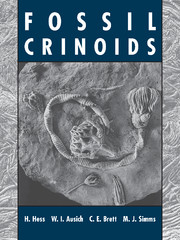Book contents
- Frontmatter
- Contents
- List of Contributors
- Acknowledgements
- Prelude
- Introduction
- GENERAL PART
- ASSEMBLAGES
- 6 Middle Ordovician Trenton Group of New York, USA
- 7 Middle Ordovician of the Lake Simcoe Area of Ontario, Canada
- 8 Upper Ordovician of the Cincinnati, Ohio, Area, USA
- 9 Silurian of Gotland, Sweden
- 10 Middle Silurian Rochester Shale of Western New York, USA, and Southern Ontario, Canada
- 11 Scyphocrinitids from the Silurian–Devonian Boundary of Morocco
- 12 Lower Devonian Manlius/Coeymans Formation of Central New York, USA
- 13 Lower Devonian Hunsrück Slate of Germany
- 14 Middle Devonian Windom Shale of Vincent, New York, USA
- 15 Middle Devonian Arkona Shale of Ontario, Canada, and Silica Shale of Ohio, USA
- 16 Lower Mississippian Hampton Formation at LeGrand, Iowa, USA
- 17 Lower Mississippian Burlington Limestone along the Mississippi River Valley in Iowa, Illinois, and Missouri, USA
- 18 Lower Mississippian Edwardsville Formation at Crawfordsville, Indiana, USA
- 19 Upper Pennsylvanian LaSalle Member, Bond Formation of Central Illinois, USA
- 20 Permian
- 21 Triassic Muschelkalk of Central Europe
- 22 Pentacrinites from the Lower Jurassic of the Dorset Coast of Southern England
- 23 Lower Jurassic Posidonia Shale of Southern Germany
- 24 Middle Jurassic of Southern England
- 25 Middle Jurassic of Northern Switzerland
- 26 Upper Jurassic Solnhofen Plattenkalk of Bavaria, Germany
- 27 Uintacrinus Beds of the Upper Cretaceous Niobrara Formation, Kansas, USA
- 28 Tertiary
- 29 Recent
- Appendix I Geological Time Table with Crinoid Assemblages
- Appendix II Glossary of Rocks
- Bibliography
- General Index
- Taxonomic Index
8 - Upper Ordovician of the Cincinnati, Ohio, Area, USA
Published online by Cambridge University Press: 10 November 2010
- Frontmatter
- Contents
- List of Contributors
- Acknowledgements
- Prelude
- Introduction
- GENERAL PART
- ASSEMBLAGES
- 6 Middle Ordovician Trenton Group of New York, USA
- 7 Middle Ordovician of the Lake Simcoe Area of Ontario, Canada
- 8 Upper Ordovician of the Cincinnati, Ohio, Area, USA
- 9 Silurian of Gotland, Sweden
- 10 Middle Silurian Rochester Shale of Western New York, USA, and Southern Ontario, Canada
- 11 Scyphocrinitids from the Silurian–Devonian Boundary of Morocco
- 12 Lower Devonian Manlius/Coeymans Formation of Central New York, USA
- 13 Lower Devonian Hunsrück Slate of Germany
- 14 Middle Devonian Windom Shale of Vincent, New York, USA
- 15 Middle Devonian Arkona Shale of Ontario, Canada, and Silica Shale of Ohio, USA
- 16 Lower Mississippian Hampton Formation at LeGrand, Iowa, USA
- 17 Lower Mississippian Burlington Limestone along the Mississippi River Valley in Iowa, Illinois, and Missouri, USA
- 18 Lower Mississippian Edwardsville Formation at Crawfordsville, Indiana, USA
- 19 Upper Pennsylvanian LaSalle Member, Bond Formation of Central Illinois, USA
- 20 Permian
- 21 Triassic Muschelkalk of Central Europe
- 22 Pentacrinites from the Lower Jurassic of the Dorset Coast of Southern England
- 23 Lower Jurassic Posidonia Shale of Southern Germany
- 24 Middle Jurassic of Southern England
- 25 Middle Jurassic of Northern Switzerland
- 26 Upper Jurassic Solnhofen Plattenkalk of Bavaria, Germany
- 27 Uintacrinus Beds of the Upper Cretaceous Niobrara Formation, Kansas, USA
- 28 Tertiary
- 29 Recent
- Appendix I Geological Time Table with Crinoid Assemblages
- Appendix II Glossary of Rocks
- Bibliography
- General Index
- Taxonomic Index
Summary
THE ‘PUBLISHING AMATEURS’
The Upper Ordovician of North America is the Cincinnatian Series, named for the richly fossiliferous beds in the Ohio—Indiana—Kentucky tri-state area surrounding Cincinnati, Ohio. This area is near or beyond the southern extent of Pleistocene glaciation, so bedrock is exposed or covered only thinly with glacial sediments. Hillsides, stream beds and road cuts expose the interbedded shale and limestone Cincinnatian strata, and fossils virtually tumble from rocks into collecting bags. This physical backdrop of abundant fossils and layered strata has been an intellectual seed for more than a century and a half. Many now-famous palaeontologists grew up in Cincinnati, including R. S. Bassler, J. M. Nickles, C. Schuchert and E. O. Ulrich. Caster (1981) referred to early Cincinnati geologists as the ‘publishing amateurs’ or in the case of those just listed as the ‘amateurs-turned-professionals’.
Bryozoans and brachiopods are the most prolific Cincinnatian fossils, but trilobites and echinoderms are the prizes of these strata. Crinoids are the most abundant echinoderms of the Cincinnatian, but asteroids, cyclocystoids, edrioasteroids, rhombiferans and stylophorans are also known from these beds.
STRATIGRAPHIC CYCLES
At an estimated 20°S palaeolatitude, Cincinnatian sediments were deposited in a tropical, shallow-water epicontinental setting, approximately 440 million years before present. The composite outcrop section in Ohio consists of more than 300 m of interbedded fossiliferous limestones and shales. Eustatic sea level fluctuations and storms were apparently the dominant physical factors controlling sedimentation, and this produced a hierarchy of cyclical strata.
- Type
- Chapter
- Information
- Fossil Crinoids , pp. 75 - 80Publisher: Cambridge University PressPrint publication year: 1999
- 5
- Cited by



